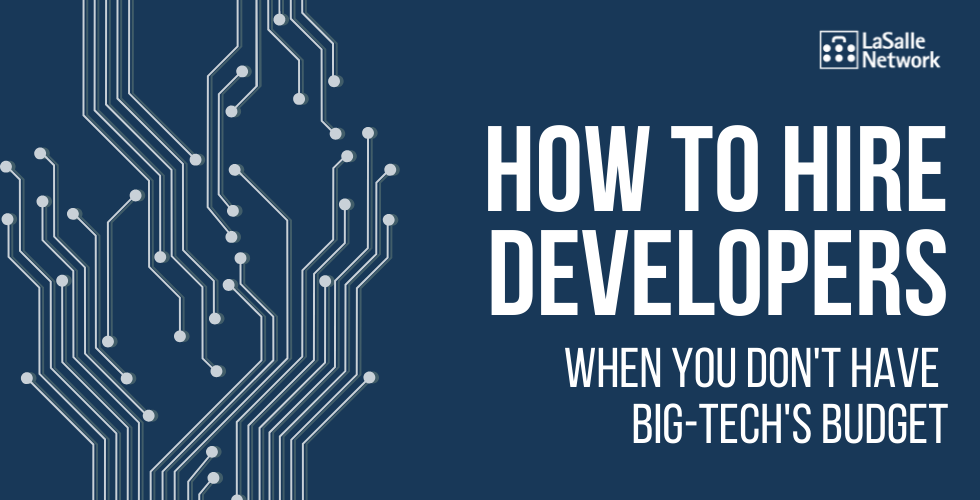Download our virtual session arming you with the tools you need to hire the best dev talent in the business, led by LaSalle Network Director Paul Wallenberg and Senior Director Kitty Brandtner. To download a recording of the event, click here.
Technology talent, especially highly skilled professionals such as software developers, are the most sought-after talent pool companies have been chasing for the last year. With the increasing focus on digital innovation in the corporate world intensifying throughout the pandemic, it is likely these professionals will continue to be some of the most in-demand and challenging to recruit for years to come.
While recruiting this talent pool, employers are not only faced with the challenge of attracting skilled developers, but also getting them committed to the new role quickly, as there is heavy competition vying for these professionals. Below we share 4 ways employers can pique technologists’ interest quickly and capture top talent.
Start with a strong job description.
With so many companies trying to grab developers’ attention, it’s essential to ensure the first impression of the role – aka the job description – is geared directly toward the applicable talent pool. Consider what it is these candidates are really after and what would make them interested enough to learn more. For instance, highlight unique projects they would have a hand in or can influence.
Go beyond listing the perks of the role, such as the ability to work remotely, and consider highlighting what collaboration tools and technology the business uses to stay connected while working remotely. Consider being transparent in the salary range and how it was arrived upon, as many developers value this transparency. Adding details like these can be helpful to spark interest and encourage candidates to learn more.
Bring in leadership early.
Involving leadership early on can demonstrate how seriously their candidacy is being taken and may help candidates become more invested in the interview process. By connecting with the hiring manager or department lead, candidates can get an idea of who they would be working with and the influence their role might have at that company right off the bat. Introducing candidates to management or executive leadership may also differentiate the interview process from others they’ve had, making the interactions and role more memorable.
Rather than hosting a long series of interview stages, involving leadership early on can also help streamline the interview process. This leaves less time for candidates to be hired by competitors. Businesses can identify redundancies in their interview process that can be eliminated by assessing what is asked of the candidate at various stages, what the specific role each interviewer is, and removing any questions that are unnecessary or could be learned from their resume. Interviewers will want to identify which stages of their traditional interviewing process are the most valuable and focus on those, removing excess back and forth wherever possible.
Make assessments your last step.
Often in the interview process employers will want candidates to complete various skills assessments; however, if this step comes before a candidate is invested in the role, employers may see a significant portion of candidates drop out of the interview process before it’s completed.
Consider, if appropriate, requesting work samples or asking situation-based questions in the interview to assess a candidate’s competency before having them complete additional assessments. Allowing candidates to explain their thinking and design process though behavioral questions may provide enough in-depth information to assess whether the candidate should move along to the next stage of an interview. For those with specific certifications, work experience or a robust portfolio, assessments may not be necessary.
Highlight unique opportunities.
A major factor in attracting developers and getting them invested in the company/role is by highlighting the unique opportunities offered to them. The key is to understand what this talent group is after and what is most valuable to them. Often, it’s not about compensation or benefits, as some may assume.
What about the business, its culture, mission or product stand out and might attract this candidate? What distinctive responsibilities or projects would the candidate be working on that separate this from other roles they may be considering?
Consider asking the candidate what about their prior role they did not like. Was their technology outdated? Were there issues in reporting structures or culture? Were they wanting more flexibility or greater responsibility? Understand the motivating factors for considering new roles and highlight how this new role may satisfy that.
Ensure the most captivating elements of the role are promoted throughout the interview process, addressing what it is that the candidate is looking for. This may include unique projects or challenges they would work on, certifications they may have access to, or decisions they may help influence. Continue to communicate throughout the interview process these and other intriguing opportunities, such as leaders they may work closely with or relevant growth opportunities.
If you’re interested in attracting top technology talent, download our virtual session that will arm you with the tools you need to hire the best in the business. To download, click here.
Let us help you recruit top technologists. Get connected with us here.




